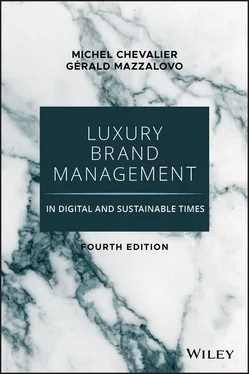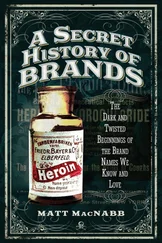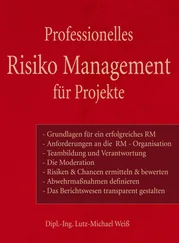In the watches category, which is obviously dominated by the Swiss, the French and Italians are merely secondary players.
Of the overall total, French and Italian brands account for €75 billion and €60 billion, respectively. France's strong position is built around accessories and perfumes. With the exception of Armani, Gucci, and Dolce & Gabbana, Italy seems to have been unable to impose strong perfume brands, and on top of this, those brands are not developed by Italian companies; nor does it have a strong international market in spirits.
However, Italy's strength in fashion is quite visible. Where France has 8 brands with sales of over €1 billion (Balenciaga, Cartier, Chanel, Dior, Hermès, Louis Vuitton, Saint Laurent, and Van Cleef & Arpels), with four whose core business is in the ready-to-wear world, Italy has 15 (Armani, Bottega Veneta, Bulgari, Dolce & Gabbana, Fendi, Gucci, Loro Piana, Max Mara, Moncler, Prada, Salvatore Ferragamo, Valentino, Versace, and Zegna), with 14 coming from the ready-to-wear and fashion world.
This preeminence of Italian fashion will have unexpected consequences in the long run as perfume brands are often built on the strength of ready-to-wear lines. If one day the Gucci, Prada, and Versace perfumes reach parity with those of Chanel, Dior, and Yves Saint Laurent, then Italy could become the number-one luxury operator in the world.
For reasons that will be discussed later, the French have been very slow to develop fashion and ready-to-wear brands over the past 30 years. The two major creations of French fashion brands date back to Saint Laurent and Kenzo; somehow, this looks like ancient history.
Oligopoly or Open Market?
From reading the press, it might be easy to form the conclusion that luxury has become the field of large groups and that there is no place for small operators. In fact, the real picture is quite different, as Table 2.6shows.
As will be discussed later, small operators, if they have the critical mass to be clearly international, can do quite well in this world.
The Big Three Corporations
In the luxury business, people speak generally of the big three corporations—LVMH, Kering, and Richemont. Actually, Richemont is similar in size to Estée Lauder and L'Oréal, and similar in size to major wines and spirit companies such as Diageo and Pernod Ricard. However, in this section, we will confine ourselves to these three companies. Other companies will be described at length in the next chapter.
LVMH.In Table 2.6, we took LVMH's sales to be approximately €39 billion because we removed the distribution activities from the total of €53.7 billion in 2019. The total picture is presented in Table 2.7.
Table 2.6 Major Luxury Operators, 2019 (or 2018/2019) (€ million)
Source: Annual reports or authors' estimates.
| Luxury Operators |
Sales |
|
| LVMH |
38,989 |
Total with distribution 53,700 |
| Kering |
15,383 |
|
| Richemont |
13,989 |
|
| Diageo |
12,926 |
Total with Guinness: 15,389 |
| Estée Lauder |
12,098 |
|
| L'Oréal |
11,000 |
Total with mass market, etc.: 29,900 |
| Pernod Ricard |
8,448 |
|
| EssilorLuxottica |
8,880 |
Total: 16,160 |
| Coty |
8,646 |
|
| Chanel |
8,400 |
|
| Hermès |
5,960 |
|
| Ralph Lauren |
5,704 |
|
| Capri |
5,566 |
|
| Tapestry |
5,409 |
|
Table 2.7 LVMH: Sales and Results, 2009 and 2019
Source: LVMH annual reports.
|
2019 Sales (€ million) |
2009 Sales (€ million) |
2019 Operating Profit (€ million) |
Profit On Sales (%) |
| Wines and spirits |
5,576 |
2,740 |
1,729 |
31.0 |
| Fashion and leather goods |
22,240 |
6,302 |
7,344 |
33.0 |
| Perfumes and cosmetics |
6,835 |
2,741 |
683 |
10.0 |
| Watches and jewelry |
4,405 |
764 |
736 |
16.7 |
| Selective distribution |
14,711 |
4,533 |
1,395 |
9.5 |
| Miscellaneous |
(67) |
(27) |
(383) |
|
| Total |
53,700 |
17,053 |
11,504 |
21.4 |
As we can see, LVMH is a very impressive group, with more than half of its luxury brand business done in the fashion and leather division. It is also striking to note that this fashion business provides 64% of the group's total operating profits.
2019 was clearly a very good year for the group. From 2009 to 2019, the growth was spectacular. This is a result of operational growth, but also company purchases, and the list is long: Celine, Fendi, Loro Piana, Bulgari, and recently.
Table 2.8 Scorecard of LVMH Results (€ million)
Source: LVMH annual reports.
|
2019 |
|
2014 |
|
2009 |
|
| Sales |
53,700 |
100% |
30,638 |
100% |
17,053 |
100% |
| Operating profit |
11,504 |
21.4% |
5,718 |
18.7% |
3,352 |
19,6% |
| Net profit |
7,171 |
13,3% |
5,648 |
18,4% |
1,973 |
11.6% |
LVMH's overall performance for 2009, 2014, and 2019 is summarized in Table 2.8.
The net profit of 13.3% of sales is not bad in 2019, but the operating profit of the fashion division (33% of sales) and of wines and spirits (31% of sales) is very impressive and probably one of the highest in the industry. But this percentage is interesting for another reason: Table 2.7shows that for the perfume business, there were recorded sales of €6,835 billion, with an operating profit of €683 million. We can estimate a net profit of €137 million. 1In other words, the perfumes and cosmetics division is providing a much lower profitability than other business sections and less than is generally expected in the perfume business.
In the luxury sectors, two segments are doing extremely well: the fashion and leather goods division, and the wines and spirits division (with its brands including Krug, Dom Pérignon, Moët and Chandon, Veuve Clicquot, and Hennessy). In the fashion and luxury division, LVMH also has many brands, including Louis Vuitton, Dior, Fendi, and Loro Piana. The question here is to determine which of these should be given priority. It seems that, based on size and potential, Celine is given major resources and development money. But Berluti, the only exclusively masculine fashion brand, seems to have an impressive business plan with the opening of many self-standing monobrand stores. The question still remains: What is the future of the other brands, if they are not profitable or only marginally contributing to the group profit?
In geographical terms, the group is well balanced, as can be seen in Table 2.9.
Table 2.9 LVMH Geographical Split, 2019
Source: LVMH annual reports. Of course, this geographical split varies across divisions and brands.
| France |
9% |
| Rest of Europe |
19% |
| America |
24% |
| Japan |
7% |
| Rest of Asia |
30% |
| Other markets |
11% |
| Total |
100% |
Kering.This group was created in 1999 by the purchase by PPR of a minority interest in Gucci and the immediate purchase of the YSL fashion and YSL beauty group. Since then, the group has purchased many other brands, including Bottega Veneta, Boucheron, and Balenciaga, and is one of the few groups that has grown by purchasing existing brands and by developing its own from scratch. This latter category includes, for example, Alexander McQueen.
Читать дальше












